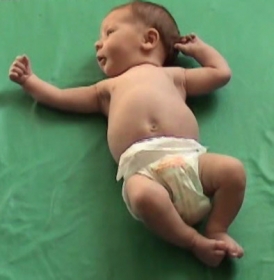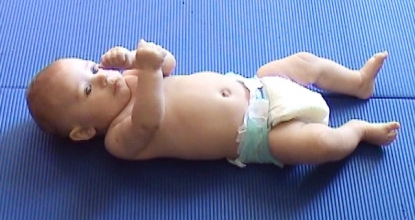Typical development of head control in supine
Position the infant in supine and take time to observe the position and movements of the head, trunk and limbs.
- In the first month the TD infant will usually turn the head to one side when lying quietly in supine.
- In the first 0-8 weeks head rotation is associated with some head-on-neck extension and lateral tilt to the opposite side.
- By 2 months rotation occurs with neutral head-on-neck flexion.


- By 2-3 months the infant should be able to maintain the head in the midline when at rest in supine, and by 3-4 months head-on-neck flexion (chin tuck) is seen.


Assessment
1 Head posture when lying quietly
Manually position the head in the midline and then remove the support.
Observe whether the infant:
| ► Maintains the head in midline, no lateral tilt. Trunk is symmetrical. |
| ► Maintains position with chin tuck (3 mo pattern). |
| ► Rotates head to the left or right - does not return to the midline.Sustained neck rotation. |
| ► Rotation is associated with head-on-neck extension and lateral flexion to the opposite side.Indicates (Atypical after 2-3 month pattern. Presence of torticollis.) |
2 Head posture when socially interacting with the therapist
Even very young infants will maintain their heads in the midline when they are engaged in looking at an interesting toy or object, or when they moving the limbs vigorously.

Let the infant lie in supine and position your face at a comfortable distance from the infant. Engage the infant socially by talking to them and making interesting sounds and faces.
Observe whether the infant:
| ► Turns the head and maintains a midline position to look at the social stimuli created by the social partner. |
| ► Is able to sustain the the midline position - at least until she decides to break off the engagement and turns away again. |
3 Head posture when excited and kicking and moving the arms.
Provide an interesting event that the infant finds very interesting within her field of vision. Infants will usually quieten their movements for a short time when looking at an interesting and novel event, followed by a brief period of excited moving of the limbs. This movement will often increase to level of muscle action in the neck flexors which helps to sustain the head in the midline.
To assess head posture when the infant is active
Let the infant lie supine on a firm surface. Encourage active kicking. You can do this by tying a small bell to one leg or placing a foil packet under the feet - the change in auditory feedback usually leads to an increase kicking activity as the infant explores the new circumstance.

Observe whether the infant:
| ► Holds the head in the midline when kicking and moving the arms. |
4 Visual following - watching a moving object
By 4-6 weeks infants are able to follow a moving object away from and towards the midline, and a little later they can follow an object from one side across the midline to the other side.


To assess visual following
Let the infant lie supine. Dangle an interesting brightly colored object about 20 cm from the infant's face, in her line of vision.
Move the object towards, across and away from midline to encourage the infant to turn the head to keep the object in view.
Also move the object towards the top of the infant's head, and then down towards the chest.
Observe whether the infant is able to follow the object:
| ► From the left and right side to the midline. |
| ► From the midline to the left or right side |
| ► From one side across the midline to the other side. |
| ► Upwards extending the head to look upwards. |
| ► Downwards, flexing the head on the neck to look downwards |
5 Reaching in supine
TD infants start to bat at toys from the first weeks. To do this successfully the infant holds the head and trunk steady and may make several passes before contacting the toy.

Depending on experience, infants from 2-3 months they are able to reach for and grasp suspended toys with a fair degree of accuracy keeping the head fairly steady.
Reaching for, and grasping toys that are suspended from an overhead bar allows the infant to practice maintaining the head and trunk steady while moving the arm.


To assess reaching
Position the infant supine in a play gym and suspend an easy-to-grasp toy within easy reach and of first one then the other hand, and also in the midline.
Observe whether the infant is able to keep the head steady and:
| ► Bat the toy. |
| ► Reach for and grasp the toy with one hand. |
| ► Reach for an grasp the toy with two hands. |
6 Assessment of neck ROM
Any limitation of neck movements has an effect on the ease with which the infant is able to:
- Rotate the head to the left and right
- Maintain the head in the midline
- Tilt the head up and down (chin lift and chin tuck)
Assessment rotation
Let the infant lie on a firm surface, grasp the head bilaterally and keeping the head in neutral lateral tilt and head-on-neck flexion, turn the head to the left and right.
Note the range of rotation, any resistance to the passive movement and end feel. Typical ROM 900
Assessment of lateral flexion
Let the infant lie on a firm surface, grasp the head bilaterally and keeping the head in neutral lateral tilt and head-on-neck flexion, turn the head to the left and right. Typical ROM 70 degrees.
Assessment of head-on-neck flexion and flexion
Let the infant lie on a firm surface.
To assess head-on-neck flexion and extension: Support the head with one hand on the occiput and the other on the forehead. With the occiput hand tilt the head forward on the neck, bringing the chin to the sternal notch. Also asses extension ROM by titling the head backwards (neck extension/chin lift)
To assess neck flexion: Support the head with one hand on the occiput and the other on the forehead. Flex the neck, moving the chin towards the sternum.
Note the ROM and any resistance or apparent discomfort.
Intervention strategies
Start with active mobilization of the neck
If neck movements are restricted, it is usually best to start with gentle mobilization to release any fascial restrictions that are present to allow the infant to comfortable maintain the head in the midline and extend and flex the head on the neck. (chin tip and tuck). For details of active mobilization see Active mobilization

Work on maintaining the head in the midline
The most effective way to encourage the infant to maintain the head in the midline is to provide interesting social stimuli or objects to look at. Stimulating the infant to pay attention in a sustained way will help to develop the infants ability to stabilize the head in order to maintain the gaze on interesting visual stimuli.

If the infant has difficulty maintaining the head in the midline, it may be helpful to provide some lateral support to the head. You can use soft beanbags for this, or a rolled up receiving blanket or shawl. Tuck the roll under the shoulder girdle to facilitate forward reach with the arms.
If the infant tends to lie with the head in extension, place a folded towel under the head the maintain some head-on-neck flexion.

To encourage more active flexion and stabilization of the trunk, tilt the pelvis posteriorly and place a folded up towel or soft beanbag under the pelvis to maintain the tilt. (You can make a soft malleable beanbag using birdseed.)

Caregivers can also cradle the head with their hands - this is a good way to provide support as the amount of support can be adapted in response to the infants head movements.

Letting the child lie in a nest made of a duvet sometimes or on a pillow may provide enough support to allow the infant to maintain midline position.


Work with the infant's caregivers to identify times within the daily routine where short periods of face to face social activity can take place. Changing a diaper, dressing and undressing, taking a break to play all provide opportunities for promoting head posture in supine.
Work on reaching for suspended toys
Let the infant lie on a play mat which has a means for suspending toys in different positions.
Provide some lateral support for the head if needed. Use a folded towel or small sand bags
Observe the infant's arm actions - then position suspended toy so that spontaneous movement of the UEs brings the hand into contact with the toy. Allow the infant to explore the relationship between her hand and the toy.
Once the infant is actively moving the hand to the toy, batting or grabbing it, move the toy a little closer to the midline to encourage the infant to turn the head and reach towards the midline.


Practice sit-backs
If an infant still has a head lag, practicing lowering the infant from sitting to supine will often facilitate increased neck and trunk muscle action.
Start with the infant in sitting, grasp her upper arms or forearms (depending on the amount od support needed) and slowly lower her trunk to the point where the infant is about to loose control. Maintain this position briefly and then bring her erect again.


